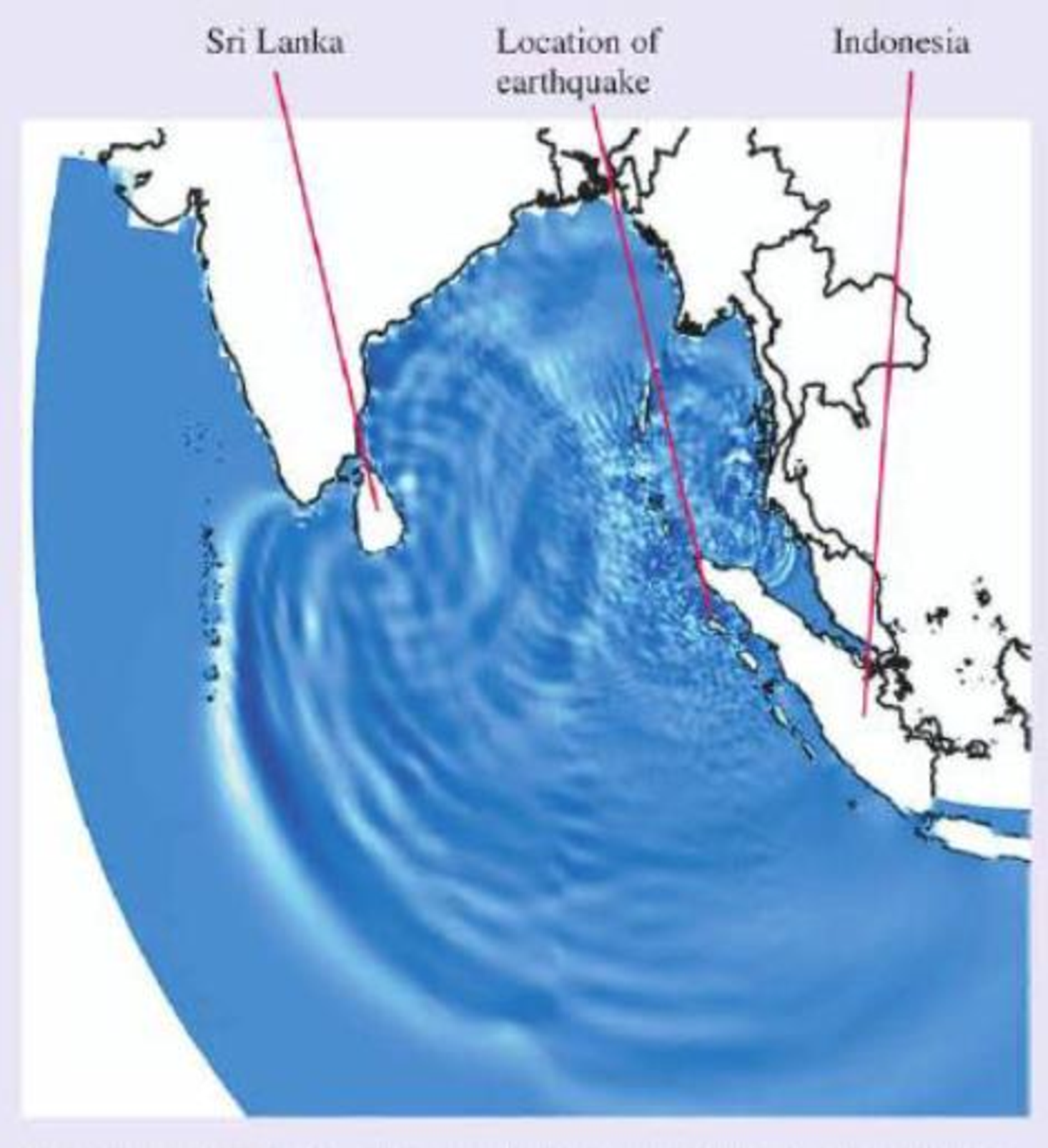
Concept explainers
Waves in the Earth and the Ocean
In December 2004, a large earthquake off the coast of Indonesia produced a devastating water wave, called a tsunami, that caused tremendous destruction thousands of miles away from the earthquake's epicenter. The tsunami was a dramatic illustration of the energy carried by waves.
It was also a call to action. Many of the communities hardest hit by the tsunami were struck hours after the waves were generated, long after seismic waves from the earthquake that passed through the earth had been detected al distant recording stations, long after the possibility of a tsunami was first discussed. With better detection and more accurate models of how a tsunami is formed and how a tsunami propagates, the affected communities could have received advance warning. The study of physics may seem an abstract undertaking with few practical applications, but on this day a better scientific understanding of these waves could have averted tragedy.
Let’s use our knowledge of waves to explore the properties of a tsunami. In Chapter 15, we saw that a vigorous shake of one end of a rope causes a pulse to travel

One frame from a computer simulation of the Indian Ocean tsunami three hours after the earthquake that produced it. The disturbance propagating outward from the earthquake is clearly seen, as are wave reflections from the island of Sri Lanka.
along it, carrying energy as it goes. The earthquake that produced the Indian Ocean tsunami of 2004 caused a sudden upward displacement of the seafloor that produced a corresponding rise in the surface of the ocean. This was the disturbance that produced the tsunami, very much like a quick shake on the end of a rope. The resulting wave propagated through the ocean, as we see in the figure.
This simulation of the tsunami looks much like the ripples that spread when you drop a pebble into a pond. But there is a big difference—the scale. The fact that you can see the individual waves on this diagram that spans 5000 km is quite revealing. To show up so clearly, the individual wave pulses must be very wide—up to hundreds of kilometers from front to back.
A tsunami is actually a “shallow water wave,” even in the deep ocean, because the depth of the ocean is much less than the width of the wave. Consequently, a tsunami travels differently than normal ocean waves. In Chapter 15 we learned that wave speeds are fixed by the properties of the medium. That is true for normal ocean waves, but the great width of the wave causes a tsunami to “feel the bottom.” Its wave speed is determined by the depth of the ocean: The greater the depth, the greater the speed. In the deep ocean, a tsunami travels at hundreds of kilometers per hour, much faster than a typical ocean wave. Near shore, as the ocean depth decreases, so docs the speed of the wave.
The height of the tsunami in the open ocean was about half a meter. Why should such a small wave—one that ships didn't even notice as it passed—be so fearsome? Again, it's the width of the wave that matters. Because a tsunami is the wave motion of a considerable mass of water, great energy is involved. As the front of a tsunami wave nears shore, its speed decreases, and the back of the wave moves faster than the front. Consequently, the width decreases. The water begins to pile up, and the wave dramatically increases in height.
The Indian Ocean tsunami had a height of up to 15 m when it reached shore, with a width of up to several kilometers. This tremendous mass of water was still moving at high speed, giving it a great deal of energy. A tsunami reaching the shore isn’t like a typical wave that breaks and crashes. It is a kilometers-wide wall of water that moves onto the shore and just keeps on coming. In many places, the water reached 2 km inland.
The impact of the Indian Ocean tsunami was devastating, but it was the first tsunami for which scientists were able to use satellites and ocean sensors to make planet-wide measurements. An analysis of the data has helped us better understand the physics of these ocean waves. We won’t be able to stop future tsunamis, but with a better knowledge of how they are formed and how they travel, we will be better able to warn people to get out of their way.
The following questions are related to the passage “Waves in the Earth and the Ocean” on the previous page.
The increase in height as a tsunami approaches shore is due to
A. The increase in frequency as the wave approaches shore.
B. The increase in speed as the wave approaches shore.
C. The decrease in speed as the wave approaches shore.
D. The constructive interference with the wave reflected from shore.
Want to see the full answer?
Check out a sample textbook solution
Chapter P Solutions
College Physics: A Strategic Approach (4th Edition)
Additional Science Textbook Solutions
Concepts of Genetics (12th Edition)
Microbiology with Diseases by Body System (5th Edition)
Microbiology: An Introduction
Microbiology: An Introduction
Human Biology: Concepts and Current Issues (8th Edition)
Introductory Chemistry (6th Edition)
- A shot putter releases a shot at 13 m/s at an angle of 42 degrees to the horizontal and from a height of 1.83 m above the ground. Calculate. Note: For each question draw a diagram to show the vector/s. Show all the steps and provide units in the answers. Provide answer to 2 decimal places unless stated otherwise. Answer all parts and show all work please.arrow_forwardA player kicks a football at the start of the game. After a 4 second flight, the ball touches the ground 50 m from the kicking tee. Assume air resistance is negligible and the take-off and landing height are the same (i.e., time to peak = time to fall = ½ total flight time). Calculate: Note: For each question draw a diagram to show the vector/s. Show all the step and provide units in the answers. Provide answer to 2 decimal places unless stated otherwise.)arrow_forwardIf I stand next to a wall on a frictionless skateboard and push the wall with a force of 25 N, what would my acceleration be if my mass is 75 kg?arrow_forward
- 3arrow_forward13. After a gust of wind, an orb weaver spider with a mass of 35 g, hanging on a strand of web of length L = .420 m, undergoes simple harmonic motion (SHO) with an amplitude A and period T. If the spider climbs 12.0 cm up the web without perturbing the oscillation otherwise, what is the period of oscillation, in Hz to three significant figures?arrow_forward15. An object of mass m = 8.10 kg is attached to an ideal spring and allowed to hang in the earth's gravitational field. The spring stretches 23.10 cm before it reaches its equilibrium position. The mass then undergoes simple harmonic motion with an amplitude of 10.5 cm. Calculate the velocity of the mass in m/s at a time t= 1.00s to three significant figures.arrow_forward
- please solve and answer the question correctly. Thank you!!arrow_forward18arrow_forward1. Some 1800 years ago Roman soldiers effectively used slings as deadly weapons. The length of these slings averaged about 81 cm and the lead shot that they used weighed about 30 grams. If in the wind up to a release, the shot rotated around the Roman slinger with a period of .14 seconds. Find the maximum acceleration of the shot before being released in m/s^2 and report it to two significant figures.arrow_forward
 Physics for Scientists and Engineers, Technology ...PhysicsISBN:9781305116399Author:Raymond A. Serway, John W. JewettPublisher:Cengage Learning
Physics for Scientists and Engineers, Technology ...PhysicsISBN:9781305116399Author:Raymond A. Serway, John W. JewettPublisher:Cengage Learning College PhysicsPhysicsISBN:9781938168000Author:Paul Peter Urone, Roger HinrichsPublisher:OpenStax College
College PhysicsPhysicsISBN:9781938168000Author:Paul Peter Urone, Roger HinrichsPublisher:OpenStax College An Introduction to Physical SciencePhysicsISBN:9781305079137Author:James Shipman, Jerry D. Wilson, Charles A. Higgins, Omar TorresPublisher:Cengage Learning
An Introduction to Physical SciencePhysicsISBN:9781305079137Author:James Shipman, Jerry D. Wilson, Charles A. Higgins, Omar TorresPublisher:Cengage Learning Principles of Physics: A Calculus-Based TextPhysicsISBN:9781133104261Author:Raymond A. Serway, John W. JewettPublisher:Cengage Learning
Principles of Physics: A Calculus-Based TextPhysicsISBN:9781133104261Author:Raymond A. Serway, John W. JewettPublisher:Cengage Learning Glencoe Physics: Principles and Problems, Student...PhysicsISBN:9780078807213Author:Paul W. ZitzewitzPublisher:Glencoe/McGraw-Hill
Glencoe Physics: Principles and Problems, Student...PhysicsISBN:9780078807213Author:Paul W. ZitzewitzPublisher:Glencoe/McGraw-Hill Physics for Scientists and Engineers: Foundations...PhysicsISBN:9781133939146Author:Katz, Debora M.Publisher:Cengage Learning
Physics for Scientists and Engineers: Foundations...PhysicsISBN:9781133939146Author:Katz, Debora M.Publisher:Cengage Learning





